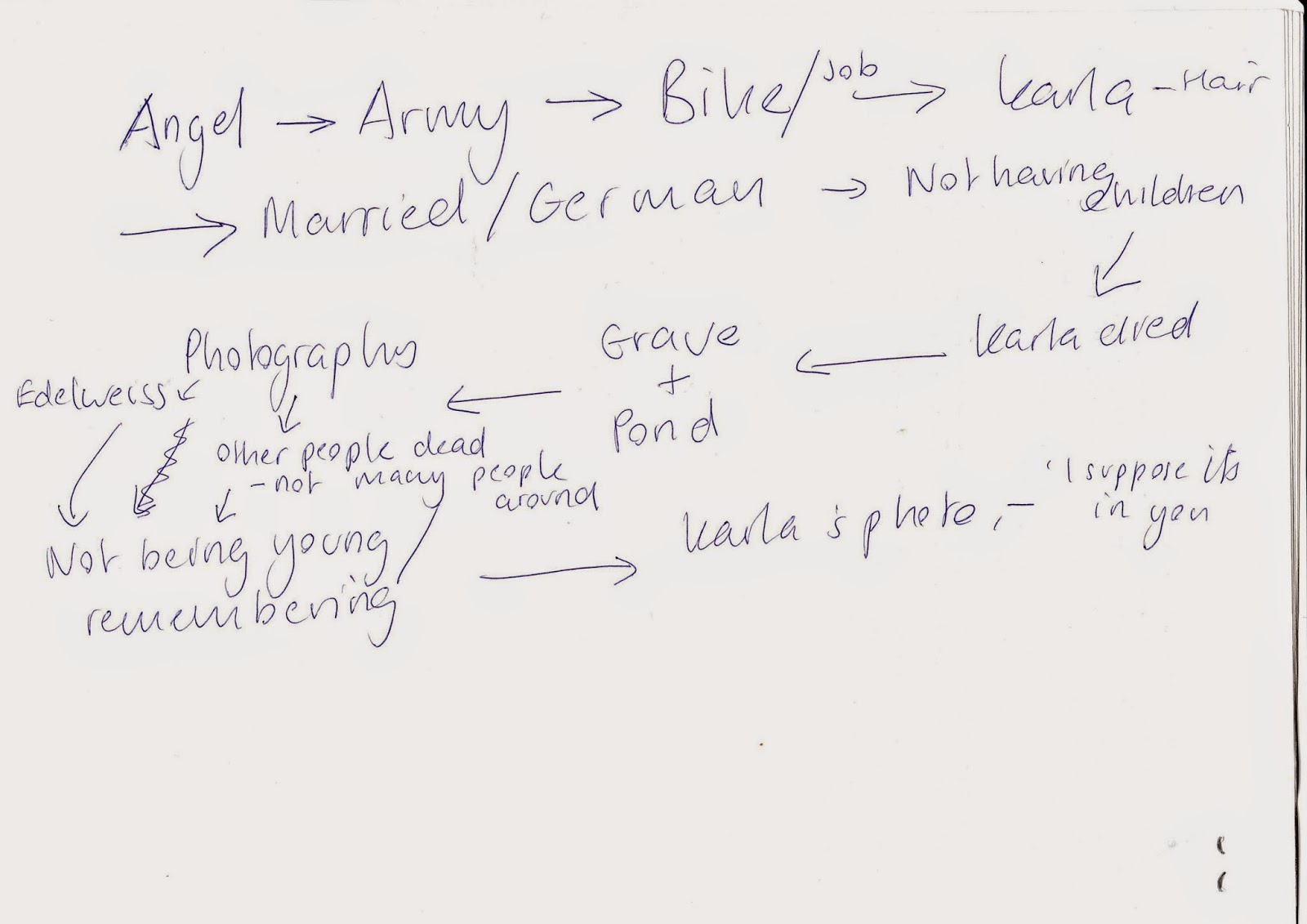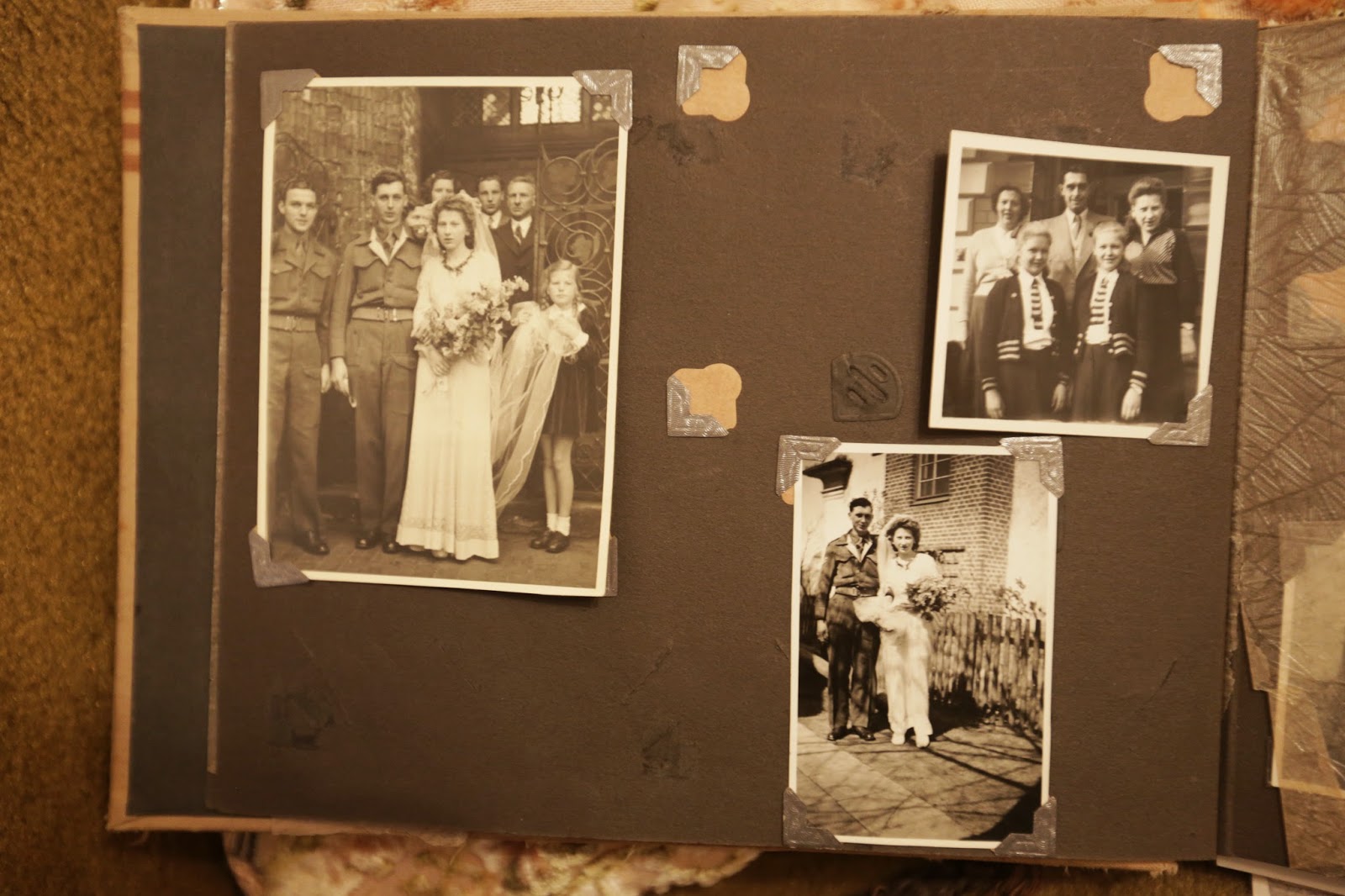Overall, I am pleased both films we have produced
despite the challenges we have faced, although our longer piece differs
from what we originally aimed to create.
Strengths
The main strength of the poetic piece is the
simplicity of the idea, the slow reveal of the photograph mirroring the
development of the memory as it is told. I feel the story and speaker are both
engaging and its editing is well paced. The subtle elements of sound design and
underlying music help to bring the memory to life but do not distract from the
speaker, and the retained nuance adds to the sense of character.
For the longer piece, its main strength Ralph's
warm and engaging character. Also, we have managed to find, structure and
present an interesting and personal story whilst avoiding an overly sentimental
tone, which would not have been representative of his character and arguably would
have undermined the film. It was a challenge for us, particularly after our
first meeting, to see where a film could be made from the various memories he
shared, but through planning and discussion we managed to extract the necessary
information.
The transition from Ralph talking about his happy
memories to talking about his wife passing away was challenging to execute
without feeling abrupt or forced. However, with the change in pace, music and tone, as well as the slow match-cut dissolve, I think we bridged the two sequences effectively and
with respect. In response to feedback we also tried to improve the pacing
throughout the entire film, giving the audience more time on the photographs
and pauses between speech. Additionally, planning and discussing the editing
structure ensured that there was efficient movement between different ideas and
scenes, finding a balance between exposition and personal anecdotes.
 |
| Planning a rough editing structure |
I am also pleased with the quality of the coverage
and cutaways, which help to provide movement to an otherwise static piece. On
our second day of filming we focused on shooting cutaways to create opportunities
in the edit, as we were still experimenting with which sections to include or
omit. We therefore had enough coverage to reinforce anything that was said and
importantly mask the high amount of editing required to deliver the story with
clarity. The photo album scans were also essential in delivering the story in a
more engaging way, and to maintain the link with the original theme of
photographs that explored in the poetic piece.
 |
| Devising a shot list |
Weaknesses
The only real issue with the poetic piece is that
some speech is hard to distinguish at the start of the film. This was mainly
due to the quality of the sound recording, which was difficult to fix despite
EQing the audio mix.
Similarly, sound was an issue in the final film among
other small technical which we did not have the time to correct. Firstly, there
is a difference in sound quality between the two microphones we used, and
switching between them is at times noticeable. In addition, due to issues we
were facing with importing media, we had less time to balance and EQ the audio
mix, leaving a couple of lines harder to distinguish under the music.
Also, due to changing light conditions some shots
are slightly underexposed or not properly white balanced. A result of the restricted space and trying to fit too much in the frame was that the shots beside Ralph in the first shoot are awkward (below), and we could not hold on them for long.
On reflection, although we made effort to slow
down the pace of the film and allow more time to look at the photographs, some
shots are still marginally too short. I can attribute this to having spent a
lot of time with the footage and not having chance to screen the film to
someone else before its completion, which I will ensure for future projects. |
| Issues maintaining eye-line |
Ultimately, although I’m happy with the final
film, it is not the film that we intended to make. Our original idea was to
find a number of older people with photographs and interweave their stories,
using poetic imagery and sound design to bring the memories to life. From the
start of the project I was aware of the difficulty and ambitiousness of
achieving this within such a short amount of time. Although we met with many
potential contributors, and the idea proved successful during the poetic
exercise, it became clear that we would have to change our focus and approach –
which we did several times throughout the project.
That said I am pleased with the way we
continuously dealt with challenges and adapted to changes, having to find and
construct a story in the late stages of production. We tried to ensure that the
film maintained at its core the same thematic concerns as our original idea, even
though we have struggled to implement the poetic techniques we explored.
Process and Contribution
At the start of the project I spent time
researching and generating ideas to share with the group. This mainly involved
looking on local news sites such as Sheffield Star, as well as various
subsections on The Guardian such as ‘Volunteering’. From here I
found a number of interesting local news stories that could be developed as film
ideas. However, the most helpful resource whilst researching was the ‘SheffieldHelp Yourself’ website, which lists every charity and organisation in the city.
Several topical issues fit the criteria of being both
achievable within our time-frame and having potential to be developed for the
poetic piece. Through discussion we also added more vague topics that could be
explored in the film such as dreams or memories, but most of these were omitted
later on as they lacked a focus or tangible story. In tutorials we narrowed the
list down to two favourites and two contingencies, and as producer I
immediately began researching and contacting potential contributors. This was
largely done online via Twitter, Facebook, sites like ‘Sheffield Forum’ and
e-mail.
 |
| Initial idea generation |
Although I did get some responses it was very
difficult to arrange to speak with anyone. Many online contacts for our
strongest idea could not be contacted by phone and/or took a long time to
respond. Also, as we were still choosing between ideas I was cautious before
arranging anything definite with contributors. On reflection this was
detrimental to our progress as we hadn't secured participants by the time we
were pitching. For future projects I will try and ensure that this process is
started sooner and that one idea is chosen to progress with to avoid confusion.
In the pitch we proposed two films; one about
libraries in Sheffield and another about photographs. Although I did not have
contributors attached, I was much more confident about the library film, and in
my research I’d contacted a number of organisations and individuals that were
interested. I was unsure about the photograph film as we didn't have a clear
approach and it relied heavily on finding appropriate contributors.
 |
| Describing our visual approach |
Therefore,
when we pursued that idea in response to peer feedback, we were immediately behind.
Through discussions and feedback in tutorials we
identified our approach for the poetic piece. I interviewed my granddad,
transcribed it and scanned the photographs they had provided. Following issues
importing the scans in to AVID, I edited the film and Jamie developed a sound
design. I also contacted a composer to create a short music track, which we
gradually refined in response to critique.
We changed the focus of the longer film to older
people, as we felt they would be easier to contact and have a higher chance of
having a photo to share. With this
change of focus, I began contacting a number of friendship groups listed under
the ‘Older People’ section of ‘Sheffield Help Yourself’. After explaining our
project I arranged meetings with several groups over the upcoming weeks. Meanwhile,
I kept my group informed via messages on our group page and regular meetings to
discuss our approach to potential contributors.
 |
| Identifying groups to approach |
Over the weeks some meetings were cancelled due
to various circumstances with the groups, and of those we visited the results
were mixed. There was a lot of initial interest and we made contacts, but
through further conversations nearly all dropped out. Despite our best efforts
to explain the film, many thought it was a film about local history, which
wasted time in the meetings. Most of those we spoke to afterwards either couldn't find photos to share or didn't want to be interviewed, which was a
major setback for the project.
 |
| Following up contributors |
With limited time we were forced to drastically change
our approach to the project, considering focusing it on my family instead.
However, after our first meeting I had stayed in touch with Ralph, who had
expressed an interest in the film. I arranged for us to meet him to see what
photos he had to show us, and from this arranged to interview him the following
week. At this stage we could not tell whether there was enough material to make
the film a portrait of Ralph, and we only had a loose understanding of his
story. Planning was therefore essential prior to the interview to obtain this
information with clarity.In preparation for the shoot I arranged meetings
to draft lists of shots, equipment and questions, create a floor plan and make
a schedule.
 |
| Questions and schedule |
 |
| Rough floor plan and camera positions |
On the day, I interviewed Ralph, helped direct the camera work and
completed necessary paperwork. Afterwards we divided the transcribing task among
us and I reviewed the footage. It was then decided that we should film again
the following week, as issues with transferring footage during the shoot wasted
time and we did not have the coverage we needed.
After arranging this with Ralph, we planned the
second shoot to cover material that we needed to tell the story. This included
listing cutaways and focusing interview questions on parts of the story that
needed clarity, or where we felt there was more to be expressed. On the second
shoot, our questions could be targeted at more interesting parts of the story, yielding
some of the best responses. By taking multiple cameras and planning our
approach, we obtained all the footage we needed. Being able to borrow and scan
the photo albums was also crucial as the stills we took on the first shoot were
unsuitable for our desired use.
 |
| Panning and zooming did not maintain quality |
Following the shoot a post-production plan was
drafted, starting with transcribing and scanning the albums. With limited time
available I also worked on a rough edit of the film at home, relaying ideas
between us to speed up the assembly process. We highlighted parts of the
transcripts and created a structure for the film, which was continually revised
as some sequences did not fit. I spent a lot of time searching for music for
the film, taking influence from ‘Eric’s Secrets’ (Lucia Zoro, 2008) due to its
similar topic and tone. As the piece
I found was copyrighted, I paid a small
fee to obtain to the rights to use it.
Elliot faced a number of issues whilst completing
his cut of the film. Trying to correct some
of the shakier shots by converting them into screen-grabs was complex and time
consuming, and the scans we had taken turned blue when imported into AVID. We
tried to rectify this by converting them into JPEGs, but they were not of the
required quality to pan and zoom into the photos. Ultimately, we had to present
the edit I had completed as we were out of time and couldn't resolve these
problems.
Conclusion and Learning
Ultimately, our change of approach to the longer piece meant there
was less opportunity to implement the poetic techniques we explored in the
first film; the long, slow zoom and subtle elements of sound design which
brought the memory to life. As a result the film is a more conventional biographical
portrait, albeit with a broader thematic concern and some poetic features. For
example, the match-cut dissolve between the photo and filmed footage, and the tone
of the music in the latter half. However, knowledge and research of the poetic form
was important during the initial stages of the project, helping both to generate
ideas and discard those which would not have suited the form.
I feel I’ve learnt a number of lessons and skills
during project, having contributed in different areas to its completion, complemented by relevant sections in the texts I have read. Firstly, how to carry out research and idea development, and approach and build
trust with contributors. I’m also more confident conducting interviews and aware of
how to plan them to get the best responses. Through editing the films I
understand the importance of pacing and the need for thorough preparation and
structuring in the early stages. I have gained valuable experience organising,
planning and directing shoots as well as operating related equipment, such as lapel
microphones.
Throughout the project we’ve had to respond
quickly to challenges and developments, continually shifting our focus and
overall approach to the film. We have worked well as a group and each member
has assisted in tasks outside their role. The main lesson I will take forward
from a producing role is to meet and secure contributors sooner in the project,
as this is the most important task and allows more time to fix issues as they arise later on.





































